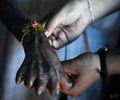The Seattle-based Infectious Disease Research Institute (IDRI) and Chembio Diagnostics, Inc. (OTC Bulletin Board: CEMI) have entered into two research and development
The Seattle-based Infectious Disease Research Institute (IDRI) and Chembio Diagnostics, Inc. (OTC Bulletin Board: CEMI) have entered into two research and development agreements for the development of rapid diagnostic tests for Leishmaniasis and Leprosy, two 'neglected diseases' targeted by IDRI. The tests will be developed by Chembio using Chembio's patented Dual Path immunoassay test platform (DPP(TM)) and will incorporate IDRI's proprietary antigens.
In preliminary studies conducted during the first quarter of 2007, Chembio demonstrated superior analytical sensitivity on certain well-characterized samples from patients with these diseases. These studies resulted in the decision by Chembio and IDRI to enter into two Cooperative Research and Development Agreements to further their joint efforts.IDRI, which has funding from the National Institutes of Heath and the Bill and Melinda Gates Foundation for the development of vaccines and diagnostics for leishmaniasis, and from the American Leprosy Mission for similar activities in leprosy, actively partners with industrial organizations to achieve its goals of developing products to aid in the control of selected diseases.
Following completion of the prototype tests this year, the parties intend to then seek commitments for procurement of these products for affected populations globally. The leishmania parasite affects millions of people worldwide, while leprosy continues to be an important public health problem, with approximately one million new cases per year. Access to better diagnostic tools will be essential for control of theses diseases.
About Leishmaniasis
Leishmaniasis is a widespread parasitic disease with frequent epidemics in the Indian subcontinent, Africa, and Latin America and is a World Health Organization priority for vaccine development. A complex of different diseases, Leishmania parasites cause fatal infections of internal organs, as well as serious skin disease. One of the most devastating forms of leishmaniasis is a disfiguring infection of the nose and mouth. The number of cases of leishmaniasis is increasing, and it is now out of control in many areas.
Leishmaniasis is also on the rise in some developed countries, specifically southern Europe, as a result of HIV infection. Available drugs are toxic, expensive, and require long-term daily injections. Leishmania are protozoan parasites that inhabit macrophages or the white blood cells of the immune system. The parasites are transmitted by the bite of small blood sucking insects (sand flies), which are difficult to control, as they inhabit vast areas of the planet. It is estimated that about 500,000 new cases of the visceral form (kala-azar or 'the killing disease') occur each year. Most of the deaths occur in children. Those with the cutaneous forms are often left permanently disfigured.
Advertisement
About Leprosy
Advertisement
The stigma attached to leprosy has often caused those who contract the disease to be shunned by family, friends, and society. Approximately 1.6 billion people worldwide are exposed to leprosy, which is endemic in 24 countries. Approximately 500,000 new cases are found each year -- over 1,300 cases every day. It is estimated that four to five million people already suffer from, or have deformities due to, leprosy.
Approximately 20 years ago, it became possible to treat leprosy. A multidrug therapy (MDT) comprised of several drugs given orally for a period of six to twenty four or more months may cure leprosy but can cause severe side effects. Although combination antibiotic therapy provided during the early stages of the disease reduces disease progression and spread, poor diagnostics and lack of access to regular health care mean that many who develop leprosy are treated only late in the disease, after disfigurement and transmission to others have already occurred.
Source: PR Newswire
LIN/J







